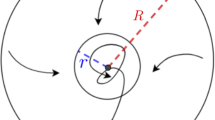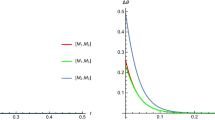Abstract
A Lyapunov function for the phase-locked state of the Kuramoto model of non-linearly coupled oscillators is presented. It is also valid for finite-range interactions and allows the introduction of thermodynamic formalism such as ground states and universality classes. For the Kuramoto model, a minimum of the Lyapunov function corresponds to a ground state of a system with frustration: the interaction between the oscillators,XY spins, is ferromagnetic, whereas the random frequencies induce random fields which try to break the ferromagnetic order, i.e., global phase locking. The ensuing arguments imply asymptotic stability of the phase-locked state (up to degeneracy) and hold for any probability distribution of the frequencies. Special attention is given to discrete distribution functions. We argue that in this case a perfect locking on each of the sublattices which correspond to the frequencies results, but that a partial locking of some but not all sublattices is not to be expected. The order parameter of the phase-locked state is shown to have a strictly positive lower bound (r ⩾ 1/2), so that a continuous transition to a nonlocked state with vanishing order parameter is to be excluded.
Similar content being viewed by others
References
B. van der Pol,London, Edinburgh, Dublin Phil. Mag. J. Sci. 3:65 (1927).
Y. Kuramoto, inInternational Symposium on Mathematical Problems in Theoretical Physics, H. Araki, ed. (Springer, Berlin, 1975), p. 420.
Y. Kuramoto,Chemical Oscillations, Waves, and Turbulence (Springer, Berlin, 1984), pp. 68–77.
Y. Kuramoto and I. Nishikawa,J. Stat. Phys. 49:569 (1987).
Y. Kuramoto,Prog. Theor. Phys. Suppl. 79:223 (1984).
G. B. Ermentrout,J. Math. Biol. 22:1 (1985).
G. B. Ermentrout,Physica D 41:219 (1990).
G. B. Ermentrout and N. Kopell,SIAM J. Appl. Math. 50:125(1990), and references therein.
S. H. Strogatz and R. E. Mirollo,J. Phys. A: Math. Gen. 21:L699 (1988).
P. C. Matthews and S. H. Strogatz,Phys. Rev. Lett. 65:701 (1990).
R. E. Mirollo and S. H. Strogatz,SIAM J. Appl. Math. 50:108, 1645 (1990).
S. H. Strogatz and R. E. Mirollo,J. Stat. Phys. 63:613 (1991).
S. H. Strogatz, R. E. Mirollo, and P. C. Matthews,Phys. Rev. Lett. 68:2730 (1992).
J. Lamperti,Probability (Benjamin, New York, 1966), Sections 7 and 8.
M. W. Hirsch and S. Smale,Differential Equations, Dynamical Systems, and Linear Algebra (Academic Press, New York, 1974), Chapter 9.
J. L. van Hemmen, D. Grensing, A. Huber, and R. Kühn,Z. Phys. 65:53 (1986);J. Stat. Phys. 50:231 (1988); J. L. van Hemmen and R. Kühn,Phys. Rev. Lett. 57:913 (1986).
W. Rudin,Real and Complex Analysis (McGraw-Hill, New York, 1974), p. 63.
A. M. Ostrowski,Solutions of Equations in Euclidean and Banach Spaces (Academic Press, New York, 1973), Appendixes A and K.
J. Stoer and R. Bulirsch,Introduction to Numerical Analysis (Springer, Berlin, 1980).
G. Iooss and D. D. Joseph,Elementary Stability and Bifurcation Theory (Springer, Berlin, 1980).
R. Bellman,Introduction to Matrix Analysis, 2nd ed. (McGraw-Hill, New York, 1970), Section 12.5.
E. Niebur, D. M. Kammen, C. Koch, D. Ruderman, and H. G. Schuster, inNeural Information Processing Systems 3, R. P. Lippman, J. E. Moody, and D. S. Touretzky, eds. (Morgan Kaufmann, San Mateo, California, 1991), pp. 123–129.
H. Sakaguchi, S. Shinomoto, and Y. Kuramoto,Prog. Theor. Phys. 77:1005 (1987).
H. Sakaguchi, S. Shinomoto, and Y. Kuramoto,Prog. Theor. Phys. 79:1069 (1988).
M. Aizenman and J. Wehr,Commun. Math. Phys. 130:498 (1990).
H. Sompolinsky, D. Golomb, and D. Kleinfeld,Proc. Natl. Acad. Sci. USA 87:7200 (1990);Phys. Rev. A 43:6990 (1991).
R. Eckhorn, R. Bauer, W. Jordan, M. Brosch, W. Kruse, M. Munk, and H. J. Reitboeck,Biol. Cybernet. 60:121 (1988).
C. M. Gray and W. Singer,Proc. Natl. Acad. Sci. USA 86:1698 (1989).
D. O. Hebb,The Organization of Behavior (Wiley, New York, 1949), p. 62.
W. Gerstner and J. L. van Hemmen,Network 3:139 (1992).
W. Gerstner, R. Ritz, and J. L. van Hemmen,Biol. Cybernet. 68:363 (1993), and to be published.
Author information
Authors and Affiliations
Rights and permissions
About this article
Cite this article
van Hemmen, J.L., Wreszinski, W.F. Lyapunov function for the Kuramoto model of nonlinearly coupled oscillators. J Stat Phys 72, 145–166 (1993). https://doi.org/10.1007/BF01048044
Received:
Revised:
Issue Date:
DOI: https://doi.org/10.1007/BF01048044




